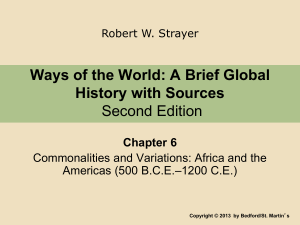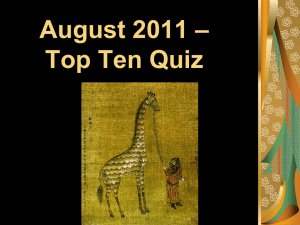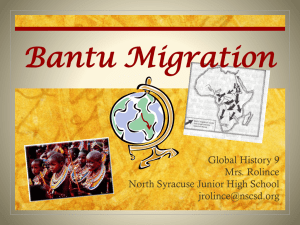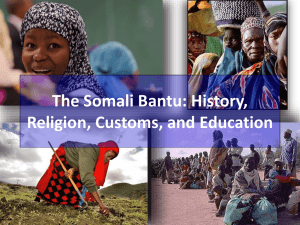Bantu Migrations - Causes & Effects
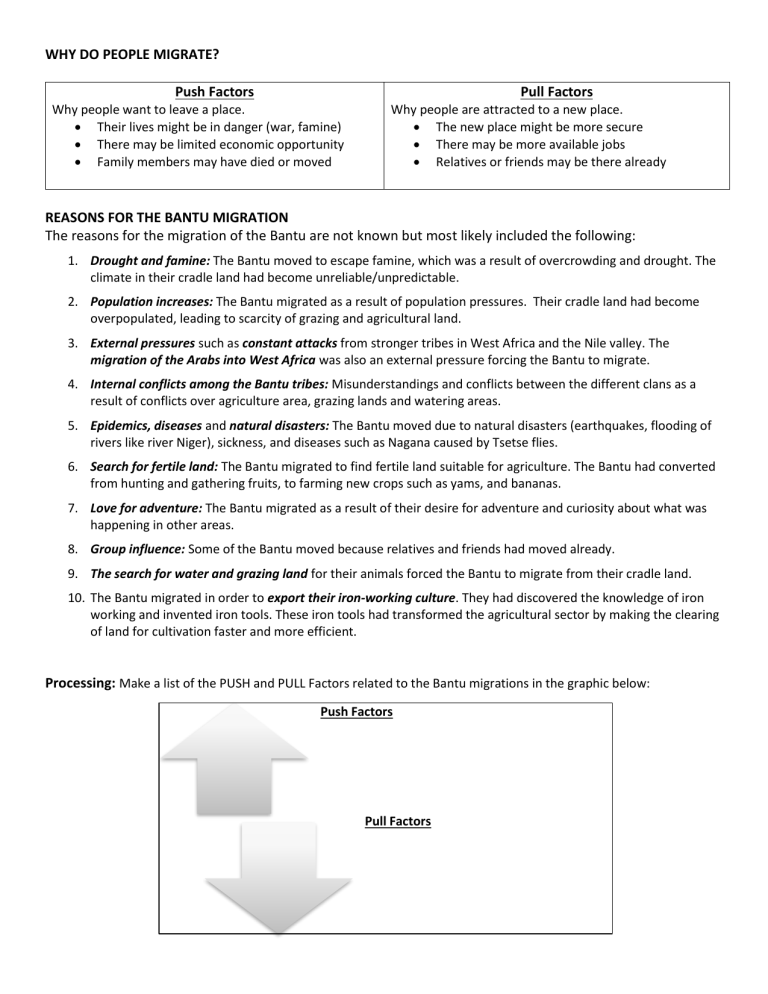
WHY DO PEOPLE MIGRATE?
Push Factors
Why people want to leave a place.
Their lives might be in danger (war, famine)
There may be limited economic opportunity
Family members may have died or moved
Pull Factors
Why people are attracted to a new place.
The new place might be more secure
There may be more available jobs
Relatives or friends may be there already
REASONS FOR THE BANTU MIGRATION
The reasons for the migration of the Bantu are not known but most likely included the following:
1.
Drought and famine: The Bantu moved to escape famine, which was a result of overcrowding and drought. The climate in their cradle land had become unreliable/unpredictable.
2.
Population increases: The Bantu migrated as a result of population pressures. Their cradle land had become overpopulated, leading to scarcity of grazing and agricultural land.
3.
External pressures such as constant attacks from stronger tribes in West Africa and the Nile valley. The
migration of the Arabs into West Africa was also an external pressure forcing the Bantu to migrate.
4.
Internal conflicts among the Bantu tribes: Misunderstandings and conflicts between the different clans as a result of conflicts over agriculture area, grazing lands and watering areas.
5.
Epidemics, diseases and natural disasters: The Bantu moved due to natural disasters (earthquakes, flooding of rivers like river Niger), sickness, and diseases such as Nagana caused by Tsetse flies.
6.
Search for fertile land: The Bantu migrated to find fertile land suitable for agriculture. The Bantu had converted from hunting and gathering fruits, to farming new crops such as yams, and bananas.
7.
Love for adventure: The Bantu migrated as a result of their desire for adventure and curiosity about what was happening in other areas.
8.
Group influence: Some of the Bantu moved because relatives and friends had moved already.
9.
The search for water and grazing land for their animals forced the Bantu to migrate from their cradle land.
10.
The Bantu migrated in order to export their iron-working culture. They had discovered the knowledge of iron working and invented iron tools. These iron tools had transformed the agricultural sector by making the clearing of land for cultivation faster and more efficient.
Processing: Make a list of the PUSH and PULL Factors related to the Bantu migrations in the graphic below:
Push Factors
Pull Factors
Effects of the Bantu Migration
1.
Introduction of iron working: they introduced iron-working and the use of iron tools in the interior of
East Africa. As a result of the shift from stone tools to iron-smelting and iron tools, there was an increase in food production.
2.
Introduction of new crops such as yams and bananas: The Bantu introduced and increased knowledge of food and crop cultivation. The introduction of iron tools allowed for a shift from hunting and gathering to agricultural cultivation throughout areas of the Bantu expansion.
3.
Cultural diffusion: The Bantu migrations led to widespread use of the Bantu languages in East Africa.
4.
New forms of government developed: The Bantu introduced a centralized system of administration.
The king acted as the overall ruler, with chiefs and lesser authorities under him.
5.
System of building permanent homes: The Bantu opened new land to settlement by families and clans, allowing for the construction of permanent villages.
6.
Technological innovations: The knowledge of iron smelting led to the making of tools for tilling and clearing land, as well as bows, arrows and spears for defense and protection.
7.
Increased trade: among African communities and with European, Swahili and Arab traders on the coasts.
8.
African state-creation: The Bantu migrations led to the creation of relatively powerful Bantu-speaking states in comparison to local chiefdoms. This was a result of denser populations, more specialized divisions of labor, and increased military power.
9.
Increased conflict: Caused by frequent attacks by the Bantu against the people East Africa for land.
10.
Loss of culture: As the Bantu intermarried with non-Bantu peoples, cultural absorption led to the loss of cultures with whom the Bantu came in contact.
11.
Transformation of language: The Bantu migration led to the spread of the Bantu language. Today, the language itself has differentiated into more than five hundred distinct languages, each representing a different ethnic group.
Processing: Decide on FIVE effects of the Bantu migrations you believe were most significant, and write a short justification for each choice.
3.
1.
2.
4.
5.



